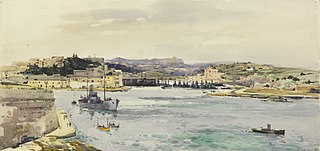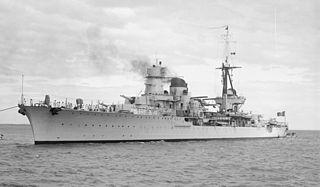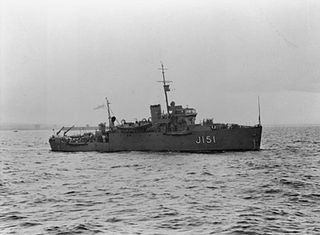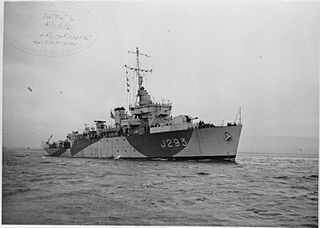
The Halcyon class was a class of 21 oil-fired minesweepers built for the British Royal Navy between 1933 and 1939. They were given traditional small ship names used historically by the Royal Navy and served during World War II.
HMS Rye (J76) was a Bangor-class minesweeper built for the Royal Navy during the Second World War.

HMS Speedy was one of 21 Halcyon-class minesweepers built for the Royal Navy in the 1930s.

HMS Hythe was a Bangor-class minesweeper built for the Royal Navy during the Second World War.

The 14th/17th Minesweeper Flotilla was a Royal Navy minesweeper flotilla based in Malta during the Second World War.

HMS Halcyon was the lead ship in her class of minesweepers built for the Royal Navy in the 1930s. The vessel was launched on 20 December 1933 and was used as a convoy escort and during the landing operations during the Invasion of Normandy during World War II. The ship was sold for scrapping in 1950.

Operation Harpoon was one of two simultaneous Allied convoys sent to supply Malta in the Axis-dominated central Mediterranean Sea in mid-June 1942, during the Second World War. Operation Vigorous was a west-bound convoy from Alexandria and Operation Harpoon was an east-bound convoy operation from Gibraltar.

Raimondo Montecuccoli was a Condottieri-class light cruiser serving with the Italian Regia Marina during World War II. She survived the war and served in the post-war Marina Militare until 1964.

HMS Clacton was a Bangor-class minesweeper built for the Royal Navy during the Second World War.
HMIS Kathiawar (J155) was a Bangor-class minesweeper built for the Royal Navy, but transferred to the Royal Indian Navy (RIN) during the Second World War.
HMIS Rohilkhand (J180) was a Bangor-class minesweeper built for the Royal Navy, but transferred to the Royal Indian Navy during the Second World War.
HMIS Kumaon (J182) was a Bangor-class minesweeper built for the Royal Navy, but transferred to the Royal Indian Navy (RIN) during the Second World War.
HMIS Carnatic (J182) was a Bangor-class minesweeper built for the Royal Navy, but transferred to the Royal Indian Navy (RIN) during the Second World War.
HMIS Rajputana (J197) was a Bangor-class minesweepers built for the Royal Navy, but transferred to the Royal Indian Navy (RIN) during the Second World War.
HMIS Konkan (J228) was a Bangor-class minesweepers built for the Royal Navy, but transferred to the Royal Indian Navy (RIN) during the Second World War.
HMIS Deccan (J129) was a Bangor-class minesweepers built for the Royal Navy, but transferred to the Royal Indian Navy (RIN) during the Second World War.

HMS Gleaner was one of 21 Halcyon-class minesweepers built for the Royal Navy in the 1930s.

HMCyS Parakrama, was a turbine-powered Algerine-class minesweeper of the Royal Ceylon Navy, originally built as HMS Pickle (J293) for the Royal Navy during World War II, and transferred to Ceylon by the United Kingdom in 1958. She was scrapped in 1964.

HMS Sharpshooter was a Halcyon-class minesweeper of the British Royal Navy. Built at Devonport Dockyard, Sharpshooter was completed in 1937. She served through the Second World War, acting both in her designed role as minesweeper and as a convoy escort, escorting several Arctic convoys. She took part in the evacuation from Dunkirk in 1940, and sank the German submarine U-655 in 1942.

HMS Chameleon (J387) was a turbine engine-powered Algerine-class minesweeper during the Second World War.












